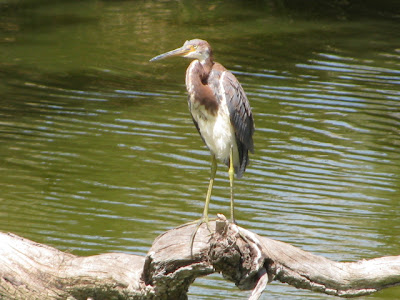I'm continuing my Heron run on BirdsEyeViews. My last two postings have been the Yellow-crowned Heron and the Black-crowned Heron. Now it's the Tricolored Heron's turn.

This bird is also or used to be called- depending on what you read- the Louisiana Heron.

What distinguishes the Tricolored from other Herons is its whte belly and the white stripe down the front of its neck.
In the photo below, you see the Tricolored (right) next to a Little Blue Heron. It's easy to differentiate between the two when you see them side-by-side like this.
I really like this next photo that captures, in a single frame, four of the most common coastal birds seen in South Carolina's Lowcountry. From left, the Great Egret, Snowy Egret, Great Blue Heron and the Tricolored Heron. This photo was taken, as are many of mine, at Charleston's Magnolia Cemetery.
This next photo, I believe, is a juvenile Tricolored Heron. The juvenile or immature one is described as similar to the adult, but more reddish.
Note the size of this young Tricolored's "feet."

I was curious about the Louisiana Heron name for this bird. With some research, I've found the name goes back at least as far back as the 1830s when the legendary naturalist, painter and birder John J. Audubon himself wrote about seeing them in Florida. Somewhere over the years the more bland name of Tricolored was adopted. Can I presume it's for the blue, gray and white colors of the adult? Please do correct if I am wrong on that point.
I've been focusing on all of the different types of Herons to be seen in my area. And the one that's really most common, I have yet to feature: the Great Blue Heron, the mightiest and most majestic of them all. That will be my next posting. But let me finish this one with a couple more Tricolored (Louisiana!) Heron shots.Gotcha!

What a lovely and graceful bird is the Tricolored Heron!









No comments:
Post a Comment